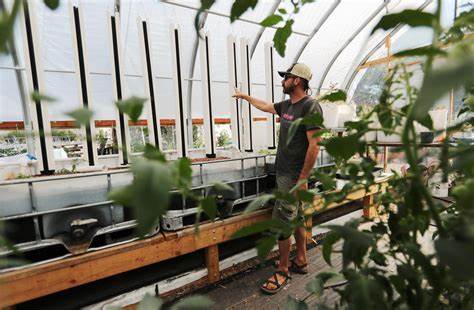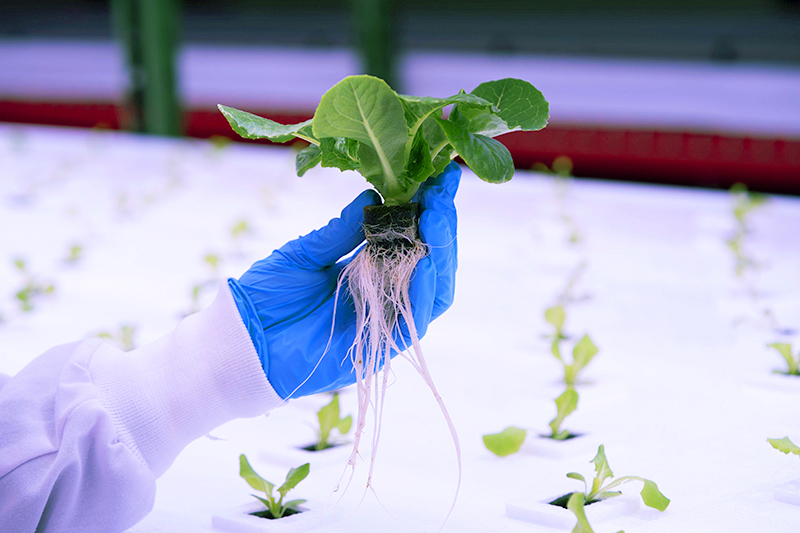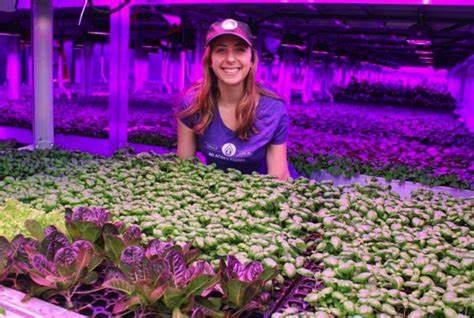
Introduction
The concept of vertical farming has gained significant traction in recent years, revolutionizing the traditional agricultural landscape. As the global population continues to grow, the need for sustainable and efficient food production methods becomes increasingly crucial. Vertical farming offers a promising solution by utilizing innovative technologies and cultivation methods to maximize crop yield while minimizing resource consumption. This article delves into the success stories of vertical farming entrepreneurs, exploring the factors that contribute to their achievements and the potential implications for the future of food production.
Historical Background
Vertical farming has evolved from conventional agricultural practices, marking a significant departure from the traditional methods of farming. The concept can be traced back to the Hanging Gardens of Babylon, dating back to ancient times. However, the modern vertical farming movement began to take shape in the early 20th century with the advent of hydroponics and aeroponics. These cultivation methods allow plants to grow in a nutrient-rich solution or mist without the need for soil, enabling cultivation in indoor environments.
In recent decades, milestones and key events have propelled the development of vertical farming. The introduction of LED lighting systems, advanced sensors, and automation technologies have revolutionized the industry, enabling year-round production and precise control over environmental factors. Vertical farming has emerged as a vital solution to address food security and sustainability challenges, particularly in urban areas with limited arable land.
Key Concepts and Definitions
Vertical farming is the practice of cultivating crops in vertically stacked layers, often in controlled environments such as warehouses or skyscrapers. It utilizes various cultivation methods, including hydroponics, aeroponics, and aquaponics, to provide optimal growing conditions for plants. Hydroponics involves growing plants in nutrient-rich water, while aeroponics involves misting plant roots with a nutrient solution. These methods eliminate the need for soil, allowing plants to grow in a soilless medium.
Controlled environment agriculture (CEA) is a key term associated with vertical farming, encompassing technologies and practices that regulate and optimize environmental factors such as temperature, humidity, and light intensity. Urban agriculture refers to the cultivation of crops in urban areas, utilizing vacant lots, rooftops, or indoor spaces. Precision agriculture involves the use of sensors and data analysis to monitor and optimize crop growth, ensuring efficient resource utilization.

Main Discussion Points
Success factors for vertical farming entrepreneurs can be attributed to various key factors. Firstly, access to capital and funding options plays a crucial role in establishing and scaling vertical farming operations. Entrepreneurs often rely on venture capital, government grants, or crowdfunding to secure the necessary resources. Technological advancements and automation are also instrumental in the success of vertical farming ventures. Automated systems for climate control, irrigation, and nutrient delivery enable efficient and precise crop management.
Market demand and consumer preferences are significant drivers for vertical farming entrepreneurs. As consumers increasingly prioritize locally sourced, pesticide-free, and sustainably grown produce, vertical farming offers a compelling solution. Entrepreneurs who can identify and cater to these demands have a higher chance of success.
Strategies employed by successful vertical farming entrepreneurs include adopting different business models tailored to their target markets. Direct-to-consumer models involve selling produce directly to consumers through online platforms or local markets. Business-to-business (B2B) models focus on supplying restaurants, grocery stores, or foodservice companies. Partnerships and collaborations with these entities can further enhance market reach and brand recognition. Scalability and expansion strategies are crucial for long-term success, as vertical farming ventures aim to increase production capacity and expand into new markets.
Case Studies or Examples
AeroFarms serves as an exemplary success story in the vertical farming industry. Founded in 2004, AeroFarms has pioneered vertical farming practices and achieved remarkable growth. By leveraging advanced aeroponic systems, AeroFarms has demonstrated significantly higher crop yields compared to traditional farming methods. The company’s sustainable and scalable approach has attracted partnerships with major retailers and foodservice companies, contributing to its success and impact on the vertical farming industry.
Plenty has made significant innovations in vertical farming technologies. With its focus on vertical hydroponic systems and advanced robotics, Plenty has achieved impressive levels of productivity and resource efficiency. The company’s vertically integrated approach allows for greater control over the entire growing process, resulting in high-quality produce and reduced environmental impact. Plenty’s success has not only revolutionized vertical farming practices but also attracted substantial investment and partnerships.
Gotham Greens exemplifies the potential for expansion and market success in vertical farming. With a focus on building commercial-scale greenhouses in urban areas, Gotham Greens has established a strong presence in multiple cities across the United States. Through strategic partnerships with grocery store chains and restaurants, the company has successfully brought locally grown, pesticide-free produce to consumers, showcasing the possibilities of vertical farming in addressing food supply chain issues.

Current Trends or Developments
Technological advancements continue to drive the evolution of vertical farming systems. Innovations in LED lighting, sensors, and automation technologies have significantly improved energy efficiency and crop productivity. The integration of artificial intelligence and machine learning algorithms enables real-time monitoring and optimization of growing conditions, maximizing yield and resource utilization. Additionally, the incorporation of renewable energy sources such as solar panels further enhances the sustainability of vertical farming operations.
The adoption of vertical farming is increasingly prevalent in urban areas and high-density regions. Limited access to arable land and the desire for locally grown produce has spurred the establishment of vertical farming facilities in cities worldwide. These urban farms not only provide fresh produce but also contribute to food security and community engagement. Vertical farming has the potential to transform underutilized urban spaces into productive agricultural hubs.
Research findings highlight the benefits of vertical farming, including higher crop yields, reduced water consumption, and decreased reliance on pesticides. By controlling environmental factors, vertical farming minimizes the risk of crop diseases and pests, enabling year-round production. The efficient use of water in closed-loop systems, combined with the recycling of nutrients, significantly reduces water consumption compared to traditional agriculture. Furthermore, vertical farming’s indoor nature reduces the need for pesticides, resulting in healthier and safer produce.
Challenges or Controversies
High initial investment costs pose a significant challenge for vertical farming entrepreneurs. Establishing a fully functional vertical farming facility requires substantial capital for infrastructure, equipment, and technology. The return on investment may take several years, making it a challenging endeavor for newcomers. Profitability can also be affected by operational costs, including energy consumption, labor, and maintenance.
Consumer perception and acceptance of vertically grown produce can be a potential barrier. Some consumers may have reservations about the perceived lack of natural sunlight and soil in vertical farming. However, educating consumers about the advantages of controlled environment agriculture, such as pesticide-free and consistently high-quality produce, can help overcome these concerns. Transparent labeling and certification can also enhance consumer trust in vertically grown products.

Regulatory and policy hurdles present challenges for vertical farming entrepreneurs. As this innovative industry continues to evolve, regulations surrounding indoor agriculture may vary across jurisdictions. Understanding and complying with food safety regulations, zoning restrictions, and building codes can be complex and time-consuming. Collaborative efforts between industry stakeholders and policymakers are necessary to establish supportive frameworks that foster innovation and growth.
Future Outlook
The vertical farming industry holds immense potential for growth and presents new market opportunities. As the demand for locally sourced, sustainable produce continues to rise, vertical farming can play a crucial role in meeting these needs. The scalability and efficiency of vertical farming systems make them suitable for both large-scale commercial operations and smaller urban farms. The integration of vertical farming with other sustainable practices, such as renewable energy generation and circular economy principles, can further enhance its environmental impact and resource efficiency.
The implications of vertical farming extend beyond food production. By reducing the reliance on traditional agricultural methods, vertical farming can free up land for other purposes, such as reforestation or urban development. Moreover, vertical farming can contribute to urban planning by revitalizing abandoned or underutilized buildings, improving the aesthetics and sustainability of urban areas.
Conclusion
In conclusion, the success stories of vertical farming entrepreneurs demonstrate the potential of this innovative approach to revolutionize food production. Access to capital, technological advancements, market demand, and strategic partnerships are key factors contributing to the success of vertical farming ventures. Despite challenges related to investment costs, consumer perception, and regulatory hurdles, the future outlook for vertical farming is promising. By embracing this sustainable and efficient farming method, we can pave the way for a resilient and food-secure future.
References
Despommier, D. (2010). The Vertical Farm: Feeding the World in the 21st Century.
Byrne, J. (2017). The Future of Vertical Farming.
Mattson, N. S., & Bates, C. C. (2014). Future Agriculture: Exploring the Potential of Vertical Farming.




